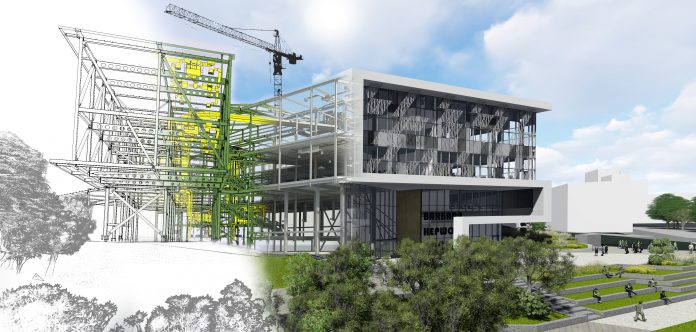Trevor Strahan, director for BIM at BakerHicks, explores the building blocks to achieving better BIM data management so the construction industry can really maximise its potential
It’s estimated that there are now 40 trillion gigabytes of data in the world. But what if over 90% of this data is actually worthless? Rather than just gathering data for the sake of it, we need to be thinking about how we are using it. It’s a case of quality over quantity, and we have some way to go yet.
This isn’t to say that some aren’t making the most out of data; it’s the big technology companies like Amazon, Apple and Facebook after all that led The Economist to state that data has replaced oil as the world’s most valuable resource. However, outside of these giants (and this includes those of us in the construction and property industry), we lag far behind in developing a true grasp of what data is important to us and how we will leverage value and benefit from the data we collect.
That’s not to say we shouldn’t be embracing the challenge, however, as the potential benefits in our industry are huge – especially considering that 80% of a building’s total cost lies in its operation and maintenance. Just imagine a scenario where the teams who maintain and operate a building have all the data they need at their fingertips. They know exactly what assets they have, whether they’re in warranty and what maintenance work is required. The data they need to optimise the building’s energy performance, avoiding wasting energy but still providing comfort, is just a click away. They’re no longer relying on lever arch files filled with copious sheets of paper, most of which is out-of-date or inaccurate. Surely, this would be of value to any organisation, saving time and money over a building’s lifetime. But just how do we achieve this?
BIM with a purpose
The answer lies with Building Information Modelling (BIM). BIM allows us to collect data during the design and construction phases, for assets as simple as lights through to major plant and equipment, providing a database of information about a facility. It’s this data that will enable facilities management teams to achieve the scenario laid out above. However, just having a BIM requirement on a project will not automatically lead to this. Without direction or purpose the data gathered simply becomes a digital equivalent of the paper lever arch files gathering dust on the shelf, a means of BIM Level 2 compliance but little else.
To get us to the next step, we need to approach BIM on every project with a goal driven end-game. This means organisations defining what data they require and how it will be used to manage the facility, all before design work begins. This allows a clear data scope to be set in a way which is valuable and meaningful to them, streamlining the approach and ensuring that the information is clear, consistent and suited to the way it will be used. Putting this in place is the first stepping stone to having quality data which works for us.
Currently, the biggest challenge to achieving this is that it’s often difficult to get the data scope defined early enough in a project. Timing is everything and to be truly effective this needs to be done before a project’s design goes out to tender. This places the onus onto the client rather than the design team, who are rarely involved in a project so early on. The foundations for this becoming the norm have been laid by the move to ISO 19650, which places the emphasis on the client to specify what they require from BIM outputs. However, many organisations will require help to get to this stage. They often don’t have the knowledge of BIM and how it can work for them, making it difficult to set a clear data scope. This is where having an in-house BIM specialist or employing a consultant to work with them to achieve this would be of huge benefit.
Specialist expertise to enhance BIM
Having access to this specialist expertise to provide access to advice and direction would transform many organisations’ experience of BIM, taking it from a box-ticking exercise to an essential, operational resource. We’ve seen this in action in our work with universities, who we’ve found to be forward-thinking in their adoption of BIM. Many now have in-house BIM teams who have taken the time to define exactly what their organisational information requirements are and what data is business-critical to them. This makes a huge difference to what they will get out of their data. Crucially, this ensures that the information they’re provided with at handover is consistent and fits their needs. This is what will then give them the ability to leverage the full power of their data to manage and maintain their facilities as effectively as possible, making time and cost savings in the process. Getting this approach in place across the board would make a huge difference to what organisations can potentially get out of BIM.
If we think ahead and look to the next level, we will see the possibilities opening up, justifying the initial outlay in bringing on that expertise. If we have our data scopes clearly set and the information delivered in a consistent format, it allows us to explore areas such as Digital Twins. This is the logical next step to getting the most out of data; pairing the virtual and physical worlds allows us to identify performance trends, spot any issues and find solutions to these. We can compare and analyse our data, learning from it as we go through a facility’s life cycle to create the most efficient building and processes possible.
We have the ideal opportunity to collect the data needed to build Digital Twins during the design and construction phases of projects. This starts with the development of a virtual replica using the BIM process, which can then be linked to the physical building through sensors, providing real-time data. By harnessing the Internet of Things and big data analytics, we can analyse productions runs, operational data and predict future trends. This will enable far more informed choices about future requirements and modifications. In fact, if we map this data really effectively we could create a cyclical information cycle that enables continuous improvements and efficiencies, ultimately increasing profitability and reducing whole-life costs.
We have the ability to achieve this, but the opportunity is currently being squandered, often right at the start, by the data requirements not being clearly set, or by the data being structured inconsistently or in such a way that it’s missing entirely. This is preventing us from realising the true potential of the information we can collect, or, even in some cases, rendering it worthless. It’s our responsibility as BIM experts, therefore, to help organisations understand the strategy and the checking processes required. Getting this right would certainly propel our data out of the worthless category.
Trevor Strahan
Director for BIM
BakerHicks
Twitter: @BakerHicks_1957
LinkedIn: Bakerhicks














